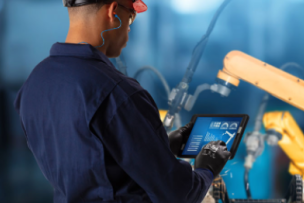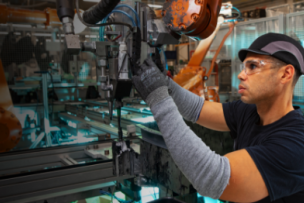Honeywell’s safety innovations protect the livelihoods of 500 million workers. With a legacy spanning over a century, Honeywell provides comprehensive PPE solutions from head-to-toe. Honeywell offers a vast of product solutions from brands you trust like Miller®, Uvex®, Howard Leight, North®, and Fibre-Metal®.
There are currently 1.7 million Electric Vehicles (EVs) on the road in the U.S. By 2030, it’s estimated there will be 25 million.1
The infrastructure needed to support the current and future adoption of EVs is an industry unto itself. Public charger availability plays a large role in consumers’ decision to transition to EVs. The most oft cited reasons for not wanting to purchase an EV are the lack of charging stations and high purchase price, followed by limited driving range and time required to charge.2 Presently, there are about 100,000 charging stations across the U.S., and the government plans to add 500,000 more chargers by 2025.3 EV goals and incentives are not just national either: many cities and regions are implementing their own strategies.
The government is playing a key role in the push for the adoption of EVs and development of infrastructure. For example, the U.S. Postal Service’s plans for a nationwide fleet of electric vehicles are getting closer to completion, with contracts having been awarded for 9,250 battery electric vehicles and for more than 14,000 charging stations. With a goal of making EVs 75 percent of its new purchases, USPS will have a fleet of 66,000 electric vehicles deployed by 2028.
To meet global emissions goals, it’s widely accepted that incentives for purchases of EVs are needed to speed up their adoption. The Inflation Reduction Act in 2022 includes a tax credit of up to $7,500 for those buying electric vehicles (both cars and SUVs) priced below $88,000.
Regulations also need to adapt quickly to accommodate the transition to an EV ecosystem. To meet the governmental goal of having 50 percent of all new vehicle sales be electric by 2030,4 the scope and depth of charging and electrical grid infrastructure needs large-scale expansion.
An extensive EV industry report from Honeywell reveals the critical role a robust infrastructure plays in reaching EV adoption goals. Here are some highlights of that report:
Electrical Grid & Charging Highlights:
- The electrification of the U.S. vehicle fleet is anticipated to be the fundamental driver of an estimated 38 percent increase in electricity demand by 2050.5
- A robust charging system plays a major role in EV purchasing decisions. For example, renters, especially in condos, townhouses, and apartments in urban areas, may not have the option to install home chargers.
- Many homeowners don’t have off-street parking, so they must rely entirely on public/workplace charging infrastructure.
- By contrast, the 20 percent of Americans who live in rural areas drive more than urban dwellers, spend more on fuel and vehicle maintenance and may have fewer alternatives to driving when going to work or school. Chargers must be able to adequately serve this population. Roughly 70 percent of America’s lane miles can be found in rural America.6
Workforce & First Responder Highlights:
- Widespread EV expansion depends on tremendous increases in the number of workers who will upgrade the grid and build thousands of charging stations.
- Significant expansion and modernization of the nation’s grid will lead to a major source of job creation within the EV ecosystem. The U.S. Department of Energy found in its 2022 Energy and Employment Report that electric vehicle jobs increased by 26.2 percent between 2020 and 2021, representing nearly 22,000 new jobs.7
- As EVs become more commonplace, a new set of protocols and training will need to be created for workers such as first responders. Attending to a road accident involving a gas-powered vehicle is vastly different from handling one involving an electric vehicle.
- Firefighters may need to use up to 40 times more water to put out an EV fire as compared to a gasoline-powered car.8
Personal Protective Equipment Highlights:
- As EV infrastructure employment increases, the need for appropriate PPE does too, including insulating rubber gloves, sleeves, and leather gloves, which together block the transmission of certain levels of electric charges. Honeywell Salisbury Electrical Safety PPE is a trusted source of hand protection, including Low Voltage Class 0 Insulated Gloves, Rubber Insulating Sleeves and Class 0 Leather Protectors.
- Protective footwear is another important category for some EV workers. Dielectric boots and overboots are necessary for high-voltage protection and to prevent charges from passing through workers’ bodies from the ground. Honeywell Salisbury Electrigrip™ Dialectric Boots and Electriguard 20kV Dielectric Overboots can be excellent choices.
- Among the biggest dangers of working with EVs is the potential for arc flash. These quick, explosive blasts can cause severe damage, including potential blindness, deafness or even death. Honeywell Salisbury is a long-standing and trusted PPE supplier for electrical safety gear, including its PrismShield™ Plus Arc Flash Head & Face Protection.
Sources:
1 https://www.experianplc.com/media/latest-news/2022/new-electric-vehicle-registrations-grew-more-than-250-over-the-last-five-years-according-to-new-experian-data/
2 https://www.businessinsider.com/americans-divided-electric-cars-jd-power-study-2023-5#:~:text=High%20purchase%20price%20and%20lack,%2C%20reliability%2C%20and%20power%20outages.
3 https://www.whitehouse.gov/briefing-room/statements-releases/2021/12/13/fact-sheet-the-biden-harris-electric-vehicle-charging-action-plan/
4 https://www.whitehouse.gov/briefing-room/statements-releases/2023/04/17/fact-sheet-biden-harris-administration-announces-new-private-and-public-sector-investments-for-affordable-electric-vehicles/#:~:text=As%20part%20of%20President%20Biden's,under%20the%20EV%20Acceleration%20Challenge
5 Analysis by the U.S. Department of Energy, 2018
6 https://www.transportation.gov/rural/ev/toolkit
7 https://electrek.co/2022/06/28/us-electric-vehicle-jobs-2021/
8 www.ctif.org/news/150-000-liters-water-needed-put-out-fire-electric-car#:~:text=In%20metric%20terms%2C%202200%20liters,battery%20pack%20becomes%20fully%20involved.
Previously Featured on Honeywell's blog.








Talk to Us!
Leave a reply
Your email address will not be published. Required fields are marked *